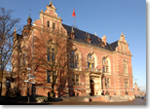Secretariat
Wały Jagiellońskie 1
80-853 Gdańsk Poland
tel. +48 58 301 09 17
tel. +48 58 301 91 23
fax +48 58 301 76 37
 Contact us
Contact us


Article by UBC EU Co-ordinator Juhan Janusson to be published in the Commission of Europe magazine "Access"
Transfrontier co-operation across the Baltic Sea
The strictest section of the Iron Curtain in Europe passed through the Baltic Sea Region. The Baltic States, except Tallinn and a few other places, were in practice inaccessible for foreigners during Soviet times. Also the GDR Coast was closed. The region was also far from the European Union when the concept of cross-border co-operation first was discussed in the European Union. Not even Denmark was an EU-member.
The concept of cross-border co-operation was shaped in the heartland of the European Union, and the first steps were taken in the very early seventies along the Dutch-German border, which is a land-border between two equal partners. The concept has indeed changed and developed since then, but it is still possible to trace the roots of the present policy to those days when the Baltic Sea still was divided into two mutually inaccessible halves. The result is that the EU transborder project funding is disadvantageous for the Baltic Sea Region as well as some neighbouring regions like Kategat between Sweden and Denmark and Skagerak between Denmark and Norway in comparison with other parts of the inland European Union.
You can find the greatest problems along maritime borders. Sweden, Finland and Norway can practically be regarded as islands from communication point of view. Except between Norway and Sweden, practically all foreign trade has to cross the sea. Transborder communications across a maritime border is thus a very natural situation for a Nordic country, but is still felt like a novelty in the European Union.
In practice EU financed transborder co-operation in the region is punished both in terms of available funding and of eligible activities. 50-80 % of the available funding for cross-border co-operation shall be directed to Interreg III Strand A. The whole coastline from Stockholm to the Öresund region as well as the Swedish and the Danish shores of Kattegat are not eligible for Interreg III Strand A funding. Also parts of the Finnish coastline along the Gulf of Bothnia and the whole coastline from northern Estonia down to Germany is not eligible for Strand A either.
The whole of the Baltic Sea Region is eligible as a region under Interreg III strand B. However, Strand B will have only 10-40 % of the Interreg III funding. It might be worth mentioning that regions eligible for Strand A are eligible also for projects under Strand B, which gives those regions double advantage.
Another problem is that many actions that are beneficial for cross-border co-operation across maritime borders are not eligible under EU Cross-border rules. Eligible investments for land border facilities, such as border crossings or joint municipal fire and rescue brigades has their maritime border equivalents in for example ferry terminals and sea rescue organisations, but the maritime actions are not eligible. There are many other examples of differences in eligibility criteria, which do not cope with the reality along a maritime border.
The Baltic States and Poland are now on their way into the EU, and Russia will become by far the most important nation bordering the European Union. This will bring new types of land borders to the regions adjacent of the Nordic countries, with differing perquisites and challenges:
- The border between EU and Russia (Finland and Russia),
- the accession countries and Russia/Belarus,
- the accession countries themselves, and
- EU and the accession countries (Germany and Poland).
Financing of cross-border projects along such borders is problematic, mainly because of different regulations regarding financing of the non-EU partners compared with the EU regions. Also rules and application procedures are more complicated compared with cross-border projects wholly inside EU.
A third problem is that the directives on transborder co-operation have their roots from borders between equal partners. The new border types, as listed above, are often borders between unequal partners. There is a need to adjust the regulations to better suit the real conditions along those border types.
It has been argued that there is more need for cross-border co-operation if there is a land-border. Facts from the Baltic Sea Region tell an other story. The need is met primarily by funding from Swedish, Danish and Finnish national sources, and from the Nordic Council of Ministers. The Swedish contribution is the largest, and some statistics show the amount of cross-border co-operation across the Baltic Sea.
Four out of five Swedish local authorities have today co-operation with local authorities on the other side of the Baltic Sea. 198 out of a total of 273 Swedish Local Authorities have twinning agreements with partners in the east. The Swedish Association of Local Authorities granted almost 3 million Euro in 1999 to 129 projects with primary funding from the Swedish Government. The Swedish Government granted funding also for regional co-operation, via NGO´s and the business community. The total Swedish contribution to co-operation projects in the Baltic Sea Region is almost 25 million Euro a year.
The national funding from Sweden and the other Nordic Countries and from the Nordic Council of Ministers compensate to some extent the lack of EU cross-border funding in the Baltic Sea Region. However, it has several severe drawbacks. It is for example difficult to carry out multinational projects, and the European perspective is missing.
One of the strategic aims of the UBC is to work for an adjustment of the present regulations to make it better adapted to the conditions in the Baltic Sea Region. It will probably take some time, but the goal is to have an adjustment at least in place until the next EU budget period, starting from year 2006.
Juhan Janusson
UBC EU Co-ordinator
e-mail: juhan@post11.tele.dk




